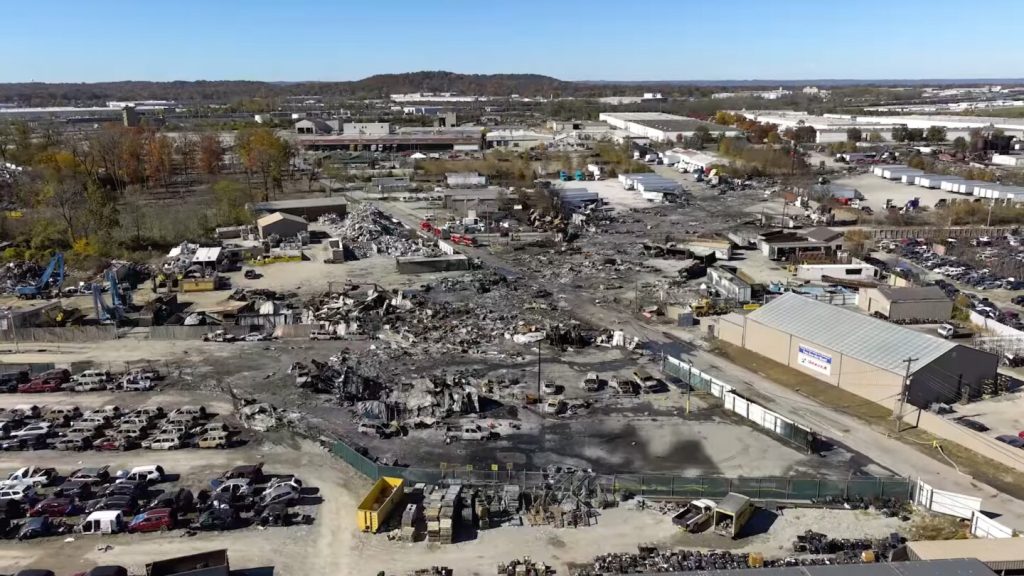Listen to the article
A UPS cargo plane crashed in a fiery explosion just moments after takeoff from Louisville, Kentucky, killing all 14 people aboard, including three pilots, officials confirmed Friday.
National Transportation Safety Board member Todd Inman revealed that cockpit recordings captured a warning bell sounding approximately 37 seconds after the crew requested takeoff thrust. Investigators have yet to determine the exact nature of the alarm, though they know the aircraft’s left wing was already on fire and its engine had detached at that point.
“For the next 25 seconds, the bell rang and the pilots tried to control the aircraft as it barely lifted off the runway,” Inman explained during a press conference. The MD-11 cargo plane, bound for Honolulu, reached a maximum altitude of only about 100 feet and a speed of 210 mph before crashing just outside the airport perimeter.
Jeff Guzzetti, a former federal crash investigator not involved in the current investigation, suggested the bell likely signaled the engine fire. “It occurred at a point in the takeoff where they were likely past their decision speed to abort the takeoff,” Guzzetti told The Associated Press. “They were likely past their critical decision speed to remain on the runway and stop safely.”
The crash happened Tuesday at UPS Worldport, the company’s global aviation hub in Louisville. The facility is UPS’s largest package handling operation, employing more than 20,000 people in the region. It typically handles 300 flights daily and sorts more than 400,000 packages per hour.
Dramatic video from multiple sources captured the horrifying sequence as the aircraft, with its left wing ablaze, plowed into nearby businesses and erupted into a massive fireball. The extensive footage from phones, vehicles, and security cameras has provided investigators with crucial evidence from numerous angles.
Investigators have recovered the left engine’s main component and pieces of fan blades from the airfield. Inman noted that UPS indicated no maintenance work was performed immediately prior to the flight, though investigators will examine video footage to determine what activities, if any, took place around the MD-11 aircraft in the days leading up to the crash.
The NTSB cautioned that it would be months before a transcript of the cockpit recording is made public as part of the standard investigation process. The agency is working methodically to establish the cause of the accident, which represents one of the most serious incidents in UPS’s aviation history.
Despite the devastating crash, UPS Worldport resumed operations Wednesday night with its Next Day Air sorting operation, according to company spokesperson Jim Mayer. The quick resumption of activities underscores the facility’s critical importance to UPS’s global logistics network.
Legal action has already begun in the wake of the tragedy. A federal lawsuit was filed Thursday against UPS by an automotive repair shop destroyed in the crash and a resident who required hospital treatment after inhaling smoke. The lawsuit, which also names the manufacturer of the plane and its engine as defendants, alleges negligence and “unreasonable harm.” The complaint seeks unspecified damages.
None of the companies named in the lawsuit had responded to requests for comment as of Friday.
The crash highlights the inherent risks in air cargo operations, which often involve older aircraft and challenging schedules. The MD-11, a three-engine widebody aircraft originally manufactured by McDonnell Douglas (now part of Boeing), has been involved in several notable accidents throughout its service history, though it has generally maintained a reasonable safety record in cargo operations.
As the investigation continues, aviation experts will be particularly interested in determining what caused the initial engine failure and fire, and whether there were any warning signs before the aircraft began its takeoff roll.
Fact Checker
Verify the accuracy of this article using The Disinformation Commission analysis and real-time sources.




6 Comments
The bell ringing for 25 seconds while the pilots tried to regain control is harrowing. I hope the investigation can provide answers for the families and help improve safety protocols for cargo plane operations.
This seems like a complex chain of events that rapidly unfolded, leaving the pilots little time to react. I’m curious to learn more about the specific technical issues that may have contributed to this accident as the investigation progresses.
Reaching only 100 feet of altitude before crashing is a devastating outcome. The potential engine fire and inability to abort the takeoff in time is very troubling. My condolences to all those affected by this tragic loss of life.
The details about the wing fire and engine detachment are concerning. It sounds like the pilots were fighting to maintain control but couldn’t recover the aircraft in time. This will be an important case study for cargo plane safety going forward.
You’re right, the rapid progression of the issues during the brief flight must have made it incredibly challenging for the pilots to respond. Rigorous analysis of the data and recordings will be crucial to understand what happened and how to prevent similar tragedies.
This is a tragic accident. The repeating bell during takeoff is an alarming detail that warrants further investigation. I hope the NTSB can determine the exact cause and any mechanical issues that may have contributed to this crash.